Chapter II -2 :Quality of the Environment in Japan 1997
Chapter II : How to Utilise Products with Consideration for the Environment
2. Promotion of Waste Disposal/Recycling Measures
As our social/economic activities continue to develop and our society becomes more and more oriented towards the paradigm of mass-production, mass-consumption and mass-disposal, many problems are emerging. The amount of disposed waste is increasing, the component parts of this waste are becoming increasingly diverse, and public confidence in the safety of disposal sites is fading. In 1993, the amount of waste taken to final disposal sites amounted to approximately l00 million tonnes (15 million tonnes of general waste and 84 million tonnes of industrial waste). To give one some idea of the quantities involved --- this quantity of waste would fill the area inside the JR Yamanote circle line (which encompasses 65 km2) to a depth of 1.5m.
Bearing in mind the mass-generation of waste and the environmental pressure posed at every stage of its existence, from initial resource extraction to final disposal, it is especially important to promote waste/recycling measures to reduce environmental pressure caused by the use of materials and products.
Reduction of Waste Generation
Because current economic/social activities and lifestyles are dependent on mass-production-consumption-disposal activities which can be considered to be wasting resources and also energy, an increased pressure is placed on the environment at every stage from resource extraction to disposal. Bearing this in mind, as we mentioned earlier, it is necessary, firstly, to revise the current production and consumption system, and reduce the generation of waste at all stages of a product's life cycle. Moreover, in order to prevent environmental contamination, the amount of toxic substances in waste needs to be reduced.
To reduce waste in business activities, it is necessary to take appropriate care in the product development, production, and marketing stages. For example, over-wrapping can be avoided and products can be made to last longer. On the consumer side, he current wasteful lifestyle should be revised and the use of disposable products should be stopped where possible. Measures to control waste generation could include the establishment of an environmental tax and a charge on products that cause a large environmental load. In some countries, especially in Western nations, environmental taxes and charges have already been employed.
| A u s t r a l i a | A u s t r i a | B e l g i u m | C a n a d a | C z e c h o | D e n m a r k | F i n l a n d | F r a n c e | G e r m a n y | G r e e c e | H u n g a r y | I c e l a n d | I r e l a n d | I t a l y | J a p a n | L u x e m b o u r g | M e x i c o | H o l l a n d | N e w Z e a l a n d | N o r w a y | P o l a n d | P o r t u g a l | S p a i n | S w e d e n | S w i t z e r l a n d | T u r k e y | U. K. | U. S. A. | ||
|---|---|---|---|---|---|---|---|---|---|---|---|---|---|---|---|---|---|---|---|---|---|---|---|---|---|---|---|---|---|
| Products | |||||||||||||||||||||||||||||
| Battery | |||||||||||||||||||||||||||||
| Plastic bag | |||||||||||||||||||||||||||||
| Disposable container | |||||||||||||||||||||||||||||
| Tyre | |||||||||||||||||||||||||||||
| CFC/Halon | |||||||||||||||||||||||||||||
| Disposable razor | |||||||||||||||||||||||||||||
| Disposable camera | |||||||||||||||||||||||||||||
| Charge on lubricant | |||||||||||||||||||||||||||||
| Charge on oil contamination |
|||||||||||||||||||||||||||||
| Solvent | |||||||||||||||||||||||||||||
| Charge on waste disposal & management |
|||||||||||||||||||||||||||||
| Charge on general waste | |||||||||||||||||||||||||||||
| Charge on waste disposal & management |
|||||||||||||||||||||||||||||
| Charge on toxic waste | |||||||||||||||||||||||||||||
| Landfill tax and charge | |||||||||||||||||||||||||||||
- Note:
- This table does not include taxes/charges imposed in the state or regional levels.
Source: Compiled by the Environment Agency by the OECD "Evaluating Economic Instruments for Environmental Policy"
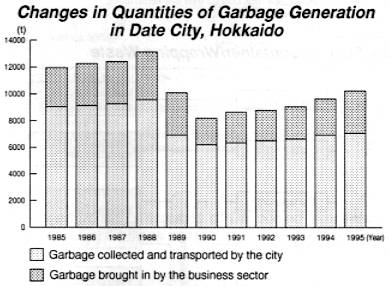
- Note:
- The figures do not include sludge discharged from households.
- Source:
- Compiled by the Environment Agency
from documents of the Date City Municipal Hygiene Centre
In some municipalities in Japan, charges are levied for the collection of certain kinds of garbage. This is working effectively to reduce waste generation. In Date City in Hokkaido, fees have been levied for the disposal of all household and industrial garbage since July 1988. In Date City, subsequent to the establishment of this 'pay to dispose' scheme, the amount of garbage generation decreased by 20%-30%.
Promotion of Reuse of Second Hand Products
If a used product is reused as it is, it generally contributes to the reduction of waste. At the same time, reusing an article means that the environmental pressure which would normally occur in its production (at all stages, from initial material extraction to final production) are avoided. Therefore, considering the pressure on the environment, from a comprehensive viewpoint, if waste is going to be generated, then the reuse of the waste should be heavily promoted.
Reuse of used products already occurs in the forms of second hand products and second hand cars, also in the forms of returnable containers and refillable containers. However, the use of returnable bottles has been decreasing in recent years, due to changes in marketing systems and apparent consumer taste.
In other countries, especially in the Western nations, laws have been devised to promote the use of returnable containers with the aim of reducing waste generation. For example, In Denmark, all beer and soft drink bottles have to be returnable and metal containers are prohibited. In Finland, Belgium, and Norway, the use of returnable containers is promoted by levying a tax on "one-way" containers.
The Environment Agency has begun a model project to disseminate and promote the use of plastic returnable containers. In 1997, it is planning to establish a concrete production/marketing/collection system in order to commercialise these products.
Returnable Container
Containers that are refilled by bottlers. These include beer bottles, 1-shou (1.8 litre) bottles, and soft drink bottles.
Refillable Container
Containers that are refilled by consumers or at retail shops. These include containers for washing liquid, detergent and hair shampoo/conditioner.
Promotion of Sound Recycling
Those products that cannot be reused as they are should be collected and used to provide raw materials. This raw material recycling reduces the consumption of natural resources and the energy necessary to create a product when compared with the environmental load that is generated by creating an equivalent product from natural resources.
When basic constituent recycling is technologically difficult or rendered inappropriate because of inevitable environmental pressures generated during the recycling process, It is necessary to promote the use of waste as an energy resource while taking the best possible environmental safety precautions in this process.
Number of Glass Bottles Used and Collected(Unit: Million)
| Bottle types | 1980 | 1989 | 1995 | ||||||
|---|---|---|---|---|---|---|---|---|---|
| Number of bottles used | Numbers collected | Collection rate (%) | Number of bottles used | Numbers collected | Collection rate (%) | Number of bottles used | Numbers collected | Collection rate (%) | |
| 1.8 litre bottles | 1,342 | 1,141 | 85 | 950 | 800 | 84 | 685 | 568 | 83 |
| Middle and small sized bottles | 512 | 102 | 20 | 570 | 57 | 10 | 667 | 34 | 5 |
| 2 litre bottles | 131 | 124 | 95 | 46 | 43 | 95 | 1 | 1 | 100 |
| Beer bottles | 6,363 | 6,045 | 95 | 6,000 | 5,550 | 92 | 4,913 | 4,863 | 99 |
| Foreign liqour bottles | 603 | 53 | 8 | 590 | 35 | 6 | 561 | 30 | 5 |
| Carbonated drinks/fruit juice | 10,476 | 9,952 | 95 | 4,400 | 3,300 | 75 | Drink bottles
2,889 |
453 | 16 |
| Lactic acid drink bottles | 134 | 31 | 19 | 100 | 9 | 9 | |||
| Seasoning bottles | - | - | - | 2,120 | 12 | 1 | 1,098 | 13 | 1 |
| Mini-drink bottles | 1,700 | 0 | 0 | 2,692 | 0 | 0 | 3,425 | 0 | 0 |
| Other bottles | 526 | 42 | 8 | 326 | - | - | 1,085 | - | - |
| Total | 21,670 | 17,438 | 80 | 17,794 | 9,811 | 55 | 15,324 | 5,962 | 39 |
- Note:
- 1. Figures for seasoning bottles in 1980 are included in "others."
- 2. "Others" are all food related bottles, except milk bottles that are returnable.
Source: National Empty Bottle Distributor Association
In Japan, there are two laws that aim to establish a system for recycling --- the Recycled Resource Use Promotion Law and the Law for Promotion of Sorted Collection and Recycling of Containers and Packaging.
In April 1997, a program was started to make the separation and collection of aluminum, steel and glass containers/wrapping, and paper cups and pet bottles more commercially viable. This followed up on the Law for Promotion of Sorted Collection and Recycling of Containers and Packaging.
Although more recycling is implemented each year, many recyclable materials are accepted by recycling firms at a cost. There is a need for transforming the present social/economic system into one which promotes recycling. In particular, the number of discarded domestic appliances and second hand cars is increasing, and a system to recycle these products needs to be established. Given this consideration, concrete investigations need to be carried out into the methods needed for the establishment of an appropriate system.
There is concern regarding the possibility that toxic substances such as heavy metal in recycled waste might contaminate soil or underground water supplies. More investigation should be carried out to prevent environmental pollution being produced when recycling toxic substances.
Recycle Flow of Container/Wrapping Waste 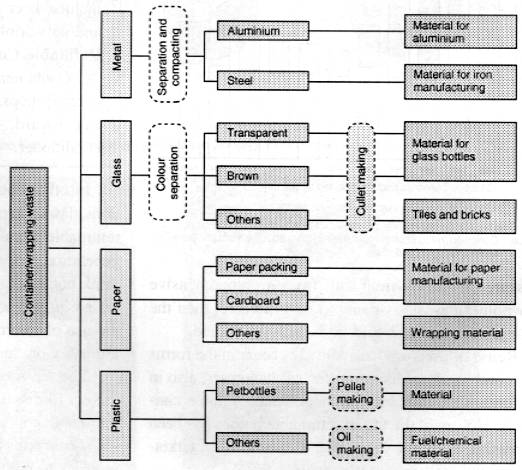
Source: Ministry of Health and Welfare
Changes in Average Boundary Prices of Recycled Materials Mass Collection
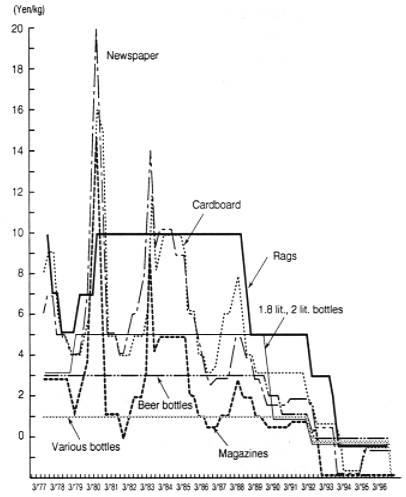
- Note:
- For the months when no boundary prices were set, the previous month's prices are used.
- Source:
- Compiled by the Environment Agency from documents issued by the Tokyo Metropolitan Resource Recovery Business Coop.
Changes in the Amounts of Disposed Household Electric Appliances and Automobiles (Estimate)
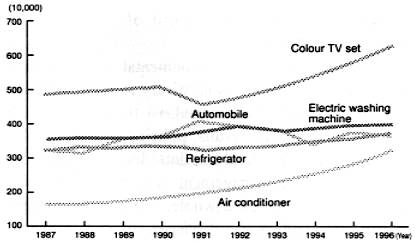
- Source:
- Compiled by the Environment Agency from documents issued by the Association for Electric Power Companies and "Japan's Privately Oned Automobiles" by the Automobile Inspection and Registration Association
Proper Waste Disposal
As for waste that cannot be recycled, environmental impact should be minimised before final disposal in landfills etc., by applying intermediate treatment such as incineration, size reduction, separation and dehydration. Also landfill sites have to be properly managed after the landfill operation has been completed and the land has been filled.
Due to advances in weight reduction measures and due to the effects of Japan's 'staggering' economy, the amount of finally disposed waste has been decreasing in recent years. This said, the amount of finally disposed waste is still very high. One of the reasons for this situation is that the environmental cost of a product is not fully reflected in terms of how much the product will cost at the final waste disposal stage.
Changes in Amount of Garbage and Final Disposal 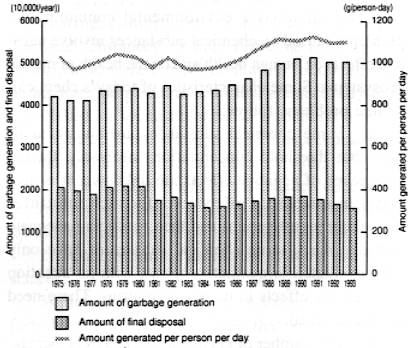
- Source:
- Compiled by the Environment Agency from documents issued by
the Ministry of Health and Welfare
Concerning the final disposal of waste, there is grave concern among citizens regarding the establishment and management of final waste disposal sites in the areas in which they live in, because of fear of environmental impact. At the same time, illegal waste disposal continues to happen.
Bearing in mind the difficulties that accompany final disposal sites and the illegal disposal of waste, the Government submitted a bill to revise the Waste Disposal Law to the Diet in March 1997. This Bill contains 1) measures to reduce waste and measures to promote recycling, 2) improvements in the credibility and safety of waste disposal procedures, and 3) measures to counter the problem of illegal waste disposal.
The Environment Agency is planning to revise and reinforce existing standards relating to final waste disposal.